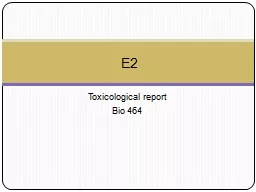

E2 Background E2 or 17 β estradiol is derived from female estrogen hormone The most potent form of mammalian estrogen steroid E2 and its synthetic derivative are important and relevant in ID: 934215
Download Presentation The PPT/PDF document "Toxicological report Bio 464" is the property of its rightful owner. Permission is granted to download and print the materials on this web site for personal, non-commercial use only, and to display it on your personal computer provided you do not modify the materials and that you retain all copyright notices contained in the materials. By downloading content from our website, you accept the terms of this agreement.
Slide1
Toxicological reportBio 464
E2
Slide2Background
E2 or 17
β
- estradiol is derived from female estrogen hormoneThe most potent form of mammalian estrogen steroidE2 and its synthetic derivative are important and relevant in ecotoxicology
Slide3BackgroundSynthetic form EE2 or
ethinyl
estradiol synthesized from estradiolEE2 is often used in oral contraceptives
Slide4Physical Properties
Fine
white
crystalline powder or creamEE2 is a hemihydrate (one molecule of water for every two molecules
of EE2)
EE2
E2
Slide5Physical property
Solubility
in water
(low solubility)– E2: 3.60 mg/l @ 27 deg C EE2: 11.3 mg/l @ 27 deg CBoth are susceptible to photodegradation
EE2 more resistant to biodegradation
Slide6Source into the Aquatic Environment
High level of E2 and EE2 often found in municipal, agricultural and industrial wastewater outfall
Human and excretion is a primary source of xenoestrogens
in an aquatic environment
Increasing use of estrogen in medicine and farming contribute to E2 and EE2 being found in aquatic environment
Slide7Mechanism of Action
At the cellular level, estrogens increase the synthesis of DNA, RNA, and various proteins in target tissues. Pituitary mass is also increased.
As a
lipophilic hormone, it diffuses readily through cellular membranes to bind to estrogen receptors situated in the nucleus.
Slide8Toxic effectsEffects of an acute dose is mild and self-limiting
LD50 > 5000 mg/kg in Rats via oral route
Both E2 and EE2 are considered endocrine
disrupting chemicalsCarcinogenicStudy in rats show growth of tumors from chronic exposure Chronic exposure in human increase risk
of
endometrial
, breast, and certain liver cancers
E2 and EE2 have
genotoxic
effect on sperm cells
Slide9Toxic effects in aquatic systems
Feminization shown in fish especially near wastewater outfall sites
Genotoxicity
shown in male fish spermStress response also shown to be affectedCortisol levels were depressed in male fish Effects not as pronounced in bivalvessusceptible to damage
by estrogens
at certain points in their
gametogenesis
process
Slide10Metabolism
Estradiol
is rapidly and completely absorbed from the gastrointestinal tractBioavailability is reported at 40%
Bioaccumulation is short term
In
rats and in humans, in that both species transform these steroids mainly by (aromatic) 2-hydroxylation
Estradiol
is primarily
converted
to estriol, which is the major urinary metabolite
Ethinylestradiol is excreted in urine and feces in a ratio of about 4:6
Slide11Slide12Bibliography
V.
Matozzo
et al. Vitellogenin as a biomarker of exposure to estrogenic compounds in aquatic invertebrates: A review. Environment
International 34 (2008)
531–545
W.J. Langston et al.
Oestrogens
and
xeno-oestrogens
in the aquatic environment. Journal of the Marine Biological Association of the United Kingdom (2005)
International Programme on Chemical Safety; Poisons Information Monograph: Ethambutol (PIM 221) (1997) Available from, as of May 19, 2005:
http://
www.inchem.org/pages/pims.html
IARC. Monographs on the Evaluation of the Carcinogenic Risk of Chemicals to Man. Geneva: World Health Organization, International Agency for Research on Cancer, 1972-PRESENT. (Multivolume work). Available at:
http://monographs.iarc.fr/index.php
p. V72 503 (1999
)
E.L.
Gregoraszczuk
et al.
Effects of
estradiol
, PCB3, and their
hydroxylated
metabolites
on proliferation
, cell cycle, and apoptosis of human breast cancer
cells.
Environmental Toxicology and Pharmacology 25 (2008)
227–233
M.
Teles
et al.
Biotransformation, stress and
genotoxic
effects of 17β-estradiol
in
juvenile
sea
bass
(
Dicentrarchus
labrax
L
.).
Environment
International 32 (2006) 470–477
Slide13BibliographyD.M.
Papoulias
et al.
An in vivo model fish system to test chemical effects on sexual differentiation and development: exposure to ethinyl estradiol
.
Aquatic
Toxicology 48 (2000)
37–50
C.M.
Ciocan
et al. Effects of estrogen exposure in mussels,
Mytilus edulis, at different stages of
gametogenesis. Environmental Pollution 158 (2010)
2977-2984
M. Ann
Rempel
et al.
Evaluation of relationships between reproductive metrics, gender
and
vitellogenin
expression in
demersal
flatfish collected near the
municipal wastewater
outfall of Orange County, California,
USA
.
Aquatic Toxicology 77 (2006) 241–249